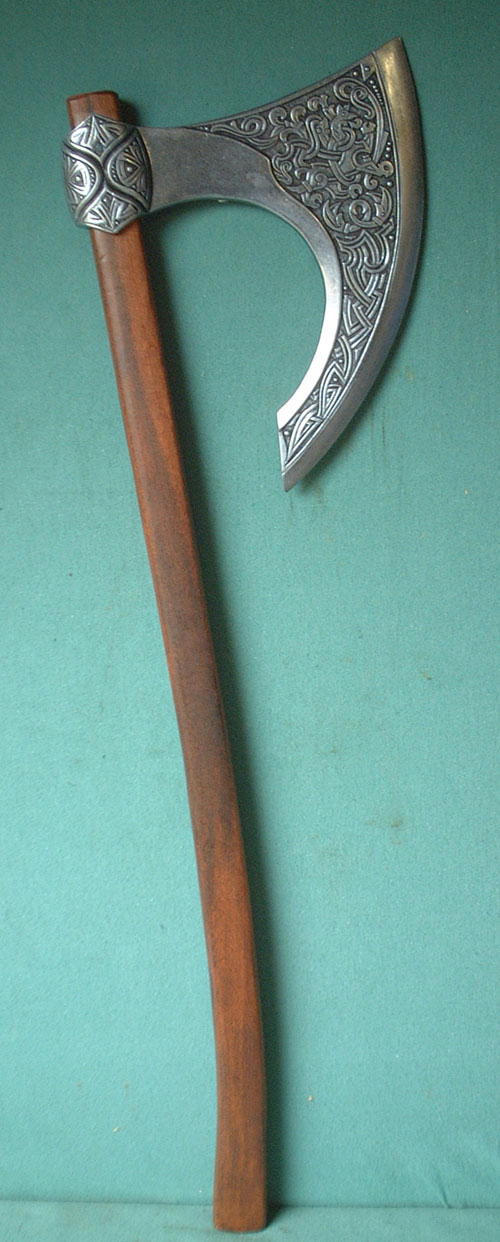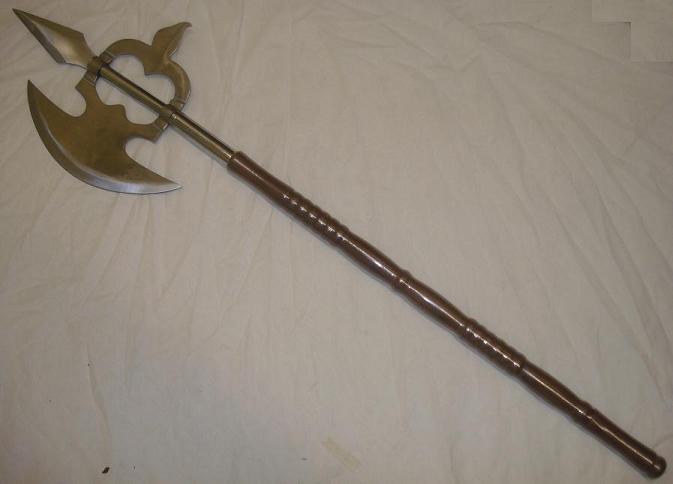

HISTORICAL BATTLE AXE PROFESSIONAL
The broadaxe gave the Viking fighter a lethal weapon worthy of a professional warrior. This axe, designed solely for battle, might be large, but the blade was thinly hammered and therefore relatively light. This changed somewhat in the latter part of the Viking Age when the era of the broadaxe dawned. Thus the axe was often identified with the landless working man, the housecarl (ON: húskarl). In contrast to the mighty landowners who proclaimed their social standing by bearing a sword as a weapon, less wealthy people resorted to using axes intended for woodworking as a weapon in battle. Illustration: Vegard Vike, Museum of Cultural History, UiO. A reconstruction showing the main design features of the axe. The sagas relate the splendour of weapons glittering with gold, clearly an ideal of the Viking Age. However, archaeology reveals that most of these weapons were, in reality, decorated with brass – a kind of poor man’s gold. Uncorroded brass resembles gold, and this seem to be of importance. In contrast to copper and bronze, which are reddish metals, brass is clearly yellow. Shone like goldĪ closer examination and the use of XRF analysis (X-ray fluorescence) confirmed that the band around the haft consisted of brass, a copper alloy containing a lot of zinc. Photo: Brynjar Sandvoll, Museum of Cultural History, UiO. Micro-sandblasting was used to clean the blade of the axe. These had to be painstakingly glued together. The copper alloy band on the haft was only half a millimetre thick, heavily corroded and shattered into multiple fragments. Copper has antimicrobial properties that prevent decay. A band of copper alloy encircled the stump of the haft, and this had preserved the wood. Before further treatment therefore, the axe was freeze-dried to reduce the risk of the wood shrinking. Quite remarkably, parts of the haft of the axe were preserved in the shape of a 15 cm long wooden stump. Damage to the surface and edges was stabilized and glue was applied before the deposits of rust could be removed by micro-sandblasting. The Langeid axe’s blade was relatively intact, and fortunately the vulnerable toe and heel of the cutting edge as well. Along one of its longer sides lay an ornate sword, and along the other a large broadaxe.

However, this changed when excavation continued around the outside of the coffin. A wooden coffin was found, but turned out to be almost empty – a disappointment for the archaeologist of course. It had substantial post holes in the corners, possibly originally supporting a roof. This proved to contain several dozen flat graves from the latter part of the Viking Age. In 2011, a burial ground was discovered during archaeological excavations at Langeid in the valley of Setesdalen. Photo: Vegard Vike, Museum of Cultural History, UiO. The broadaxe was a weapon to rival the sword as the foremost symbol of a warrior. Streamlined and elegant, but at the same time a powerful lethal weapon. In the latter part of the Viking Age, a type of axe intended for use only in battle was developed.


 0 kommentar(er)
0 kommentar(er)
